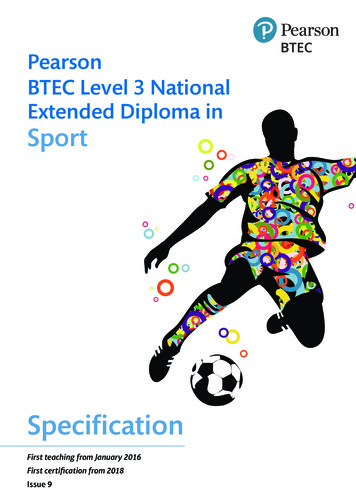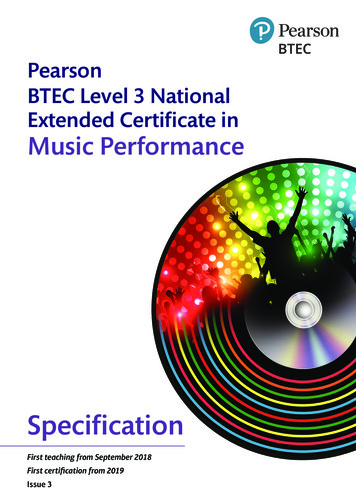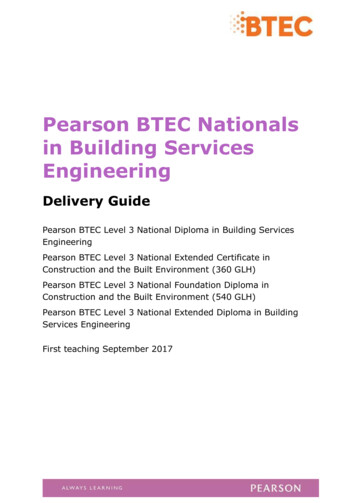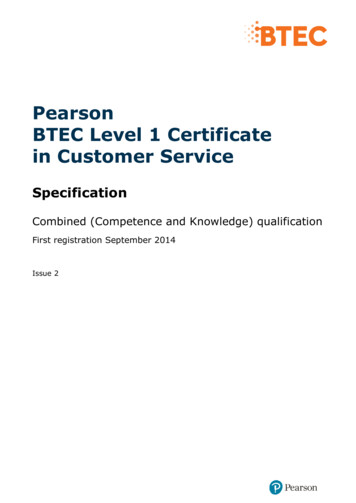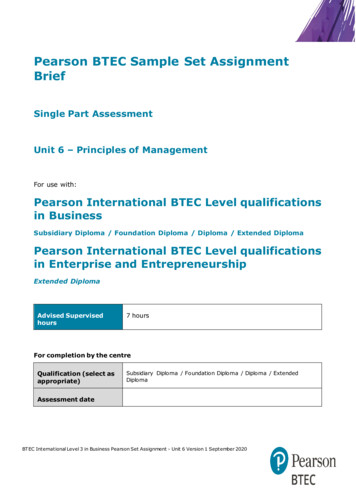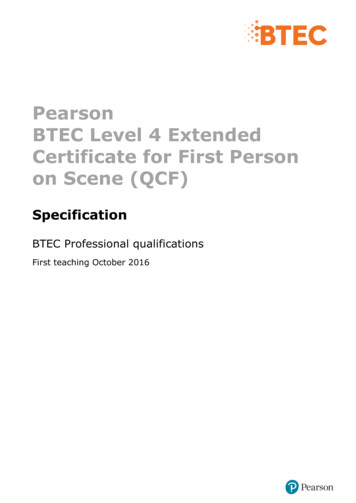
Transcription
PearsonBTEC Level 4 ExtendedCertificate for First Personon Scene (QCF)SpecificationBTEC Professional qualificationsFirst teaching October 2016
Edexcel, BTEC and LCCI qualificationsEdexcel, BTEC and LCCI qualifications are awarded by Pearson, the UK’s largest awardingbody offering academic and vocational qualifications that are globally recognised andbenchmarked. For further information, please visit our qualification websites atwww.edexcel.com, www.btec.co.uk or www.lcci.org.uk. Alternatively, you can get in touchwith us using the details on our contact us page at qualifications.pearson.com/contactusAbout PearsonPearson is the world's leading learning company, with 40,000 employees in more than70 countries working to help people of all ages to make measurable progress in their livesthrough learning. We put the learner at the centre of everything we do, because whereverlearning flourishes, so do people. Find out more about how we can help you and yourlearners at qualifications.pearson.comReferences to third-party material made in this specification are made in good faith. We donot endorse, approve or accept responsibility for the content of materials, which may besubject to change, or any opinions expressed therein. (Material may include textbooks,journals, magazines and other publications and websites.)All information in this specification is correct at time of publication.ISBN 978 1 446 93862 1All the material in this publication is copyright Pearson Education Limited 2016
Contents1Introducing BTEC Professional qualifications1What are BTEC Professional qualifications?1Sizes of BTEC Professional qualifications12Qualification summary and key information23Qualification purpose3Qualification objectives3Progression opportunities3Industry support and recognition4Qualification structure5Pearson BTEC Level 4 Extended Certificate for First Person onScene5Centre resource requirements6General resource requirements6Specific resource requirements6Access and recruitment114567Prior knowledge, skills and understanding11Access to qualifications for learners with disabilities or specificneeds11Programme deliveryDelivery guidance for Pearson BTEC Level 4 Extended Certificatefor First Person on Scene8Assessment121215Language of assessment15Internal assessment16Assessment through assignments16Making valid assessment decisions18Administrative arrangements for internal assessment20External assessment21Administrative arrangements for external assessment22Dealing with malpractice in assessment23Internal assessment24
9External assessment24Learner malpractice24Teacher/centre malpractice24Sanctions and appeals25Recognising prior learning and achievementRecognition of Prior Learning10 Centre recognition and approvalApprovals agreement2626272711 Quality assurance of centres2812 Units29Unit 1:Understanding the Roles and Responsibilities of theFirst Responder31Unit 2:Emergency Care of Casualties for the First Responder45Unit 3:Recognising and Managing Trauma for the FirstResponder65Unit 4:Recognising and Managing Medical Conditions for theFirst Responder89Unit 5:Developing the Competencies of Incident Managementfor the First Responder10513 Further information and useful publications12314 Professional development and training124
1Introducing BTEC ProfessionalqualificationsWhat are BTEC Professional qualifications?BTEC Professional qualifications are qualifications at Level 4 to Level 8 and aredesigned to provide professional work-related qualifications in a range of sectors.They give learners the knowledge, understanding and skills that they need toprogress into employment. The qualifications also provide career development andprogression opportunities for those already in work by focusing on the developmentof techniques and attributes to improve professional practice. Consequently theyprovide a course of study for full-time or part-time learners in colleges, trainingcentres and through employers.BTEC Professional qualifications put learning into the context of the world of work,giving students the opportunity to apply their research, skills and knowledge inrelevant and realistic work contexts. This applied, practical approach meanslearners build the knowledge, understanding and skills they need for careerprogression or further study.On successful completion of a BTEC Professional qualification, learners can progressto or within employment and/or continue their study in the same or relatedvocational area.Sizes of BTEC Professional qualificationsFor all regulated qualifications, Pearson specify a total number of hours that it isestimated learners will require to complete and show achievement for thequalification – this is the Total Qualification Time (TQT). The TQT value indicatesthe size of a qualification.Within the TQT, Pearson identifies the number of Guided Learning Hours (GLH) thatwe estimate a centre delivering the qualification might provide. Guided learningmeans activities, such as lessons, tutorials, online instruction, supervised study andgiving feedback on performance, that directly involve tutors and assessors inteaching, supervising and invigilating learners. Guided learning includes the timerequired for learners to complete external assessment under examination orsupervised conditions.In addition to guided learning, other required learning directed by tutors orassessors will include private study, preparation for assessment and undertakingassessment when not under supervision, such as preparatory reading, revision andindependent research.TQT is assigned after consultation with employers and training providers deliveringthe qualifications.BTEC Professional qualifications are generally available in the following sizes: Award – a qualification with a TQT value of 120 or less Certificate – a qualification with a TQT value in the range of 121–369 Diploma - a qualification with a TQT value of 370 or more.Pearson BTEC Level 4 Extended Certificate for First Person on Scene –Specification – Issue 1 – November 2016 Pearson Education Limited 20161
2Qualification summary and keyinformationQualification titlePearson BTEC Level 4 Extended Certificate forFirst Person on SceneQualification Number (QN)603/0512/5Regulation start date01/10/2016Approved age ranges16–1819 Please note that sector-specific requirements orregulations may prevent learners of a particular agefrom embarking on this qualification. Please seeSection 6 Access and recruitment.Total qualification time (TQT)184 hours.Guided Learning Hours (GLH)98AssessmentInternal assessment (centre-devised assessment)and external assessment (onscreen test).Grading informationThe qualification and units are at a Pass grade.Entry requirementsNo prior knowledge, understanding, skills orqualifications are required before learners registerfor this qualification. However, centres must followour access and recruitment policy (see Section 6Access and recruitment).FundingQualifications eligible and funded forpost-16 year olds can be found on the funding Hub.The Skills Funding Agency also publishes a fundingcatalogue that lists the qualifications available for19 funding.Centres will need to use the Qualification Number (QN) when they seek publicfunding for their learners. The qualification title, unit titles and QN will appear oneach learner’s final certificate. Centres should tell learners this when recruitingthem and registering them with Pearson. There is more information aboutcertification in our UK Information Manual, available on our website,qualifications.pearson.com2Pearson BTEC Level 4 Extended Certificate for First Person on Scene –Specification – Issue 1 – November 2016 Pearson Education Limited 2016
3Qualification purposeQualification objectivesThe Pearson BTEC Level 4 Extended Certificate for First Person on Scene is forlearners who work in, or who want to work in, the pre-hospital care industry as firstresponders. Learners will normally be employed as, or looking to apply for jobs as,a first responder in a primary care role. However, in some cases learners may beacting as a first responder as part of a secondary role in an industry which requiresfirst responders to have a greater breadth of knowledge and skill than are providedby first aid qualifications, or the Pearson BTEC Level 4 Certificate for First Person onScene.The qualification gives learners the opportunity to: develop knowledge related to the pre-hospital care industry, including how theirrole fits into the wider sector as well as the responsibilities of the firstresponder, established practices relating to the safeguarding of children andvulnerable adults, as well as the prevention and control of infection develop technical knowledge that underpins the role, duties and responsibilitiesof the first responder. This covers areas such as the management of scenesafety, the clinical care and management of the casualty, the provision ofeffective clinical handovers to the next echelon of care, as well as the postincident procedures for which the first responder is responsible develop practical skills of safe incident management and managing the care ofcasualties while awaiting the arrival of definitive pre-hospital care develop knowledge to and skills to be able to make critical decisions andmedically manage the safe extrication of casualties achieve a nationally-recognised Level 4 qualification develop their own personal growth and engagement in learning.Progression opportunitiesOnce learners have achieved this qualification they can use it as part of their jobapplications for roles in which they will be expected to act as a first responder. Suchroles may include: community first responders lowland search and rescue operatives co-responders, e.g. fire service crew, police, other emergency services close protection operatives senior cabin crewOn completion of this qualification learners will be able to apply for membership tothe Royal College of Surgeons of Edinburgh, Faculty of Pre-Hospital Care (FPHC) atLevel 4 care provider membership.Pearson BTEC Level 4 Extended Certificate for First Person on Scene –Specification – Issue 1 – November 2016 Pearson Education Limited 20163
Industry support and recognitionThis qualification is clinically endorsed by the Royal College of Surgeons ofEdinburgh, Faculty of Pre-Hospital Care (FPHC) and is supported by the NationalAssociation of Community First Responders.The monitoring of centres and the quality assurance of assessment decisions isentirely the responsibility of Pearson.4Pearson BTEC Level 4 Extended Certificate for First Person on Scene –Specification – Issue 1 – November 2016 Pearson Education Limited 2016
4Qualification structurePearson BTEC Level 4 Extended Certificate for FirstPerson on SceneThe learner will need to achieve all mandatory units outlines in the table belowbefore Pearson can award the qualification.UnitnumberMandatory unitsLevelGuidedlearninghours1Understanding the Roles and Responsibilitiesof the First Responder3102Emergency Care of Casualties for the FirstResponder4193Recognising and Managing Trauma for theFirst Responder4254Recognising and Managing Medical Conditionsfor the First Responder4235Developing the Competencies of IncidentManagement for the First Responder421Pearson BTEC Level 4 Extended Certificate for First Person on Scene –Specification – Issue 1 – November 2016 Pearson Education Limited 20165
5Centre resource requirementsAs part of the approval process, centres must make sure that the resourcerequirements below are in place before offering the qualification.General resource requirements Centres must have appropriate physical resources (for example IT, learningmaterials, teaching rooms) to support delivery and assessment. Staff involved in the assessment process must have relevant expertise andoccupational experience. There must be systems in place that ensure continuing professionaldevelopment (CPD) for staff delivering the qualification. Centres must have appropriate health and safety policies in place that relate tothe use of equipment by learners. Centres must have in place robust internal verification systems and proceduresto ensure the quality and authenticity of learners’ work as well as the accuracyand consistency of assessment decisions between assessors operating at thecentre. For information on the requirements for implementing assessmentprocesses in centres, please refer to the Pearson Edexcel NVQs, SVQs andcompetence-based qualifications – Delivery Requirements and QualityAssurance Guidance on our website. Centres must deliver the qualifications in accordance with current equalitylegislation. For further details on Pearson’s commitment to the Equality Act2010, please see Section 6 Access and recruitment. For full details of theEquality Act 2010 visit www.legislation.gov.ukSpecific resource requirementsAs well as the general resource requirements given above, there are specificresources that centres must provide. They are listed by unit below.UnitResources requiredUnderstanding the Roles andResponsibilities of the First Responder Nitrile gloves protective face masks high-visibility clothing a range of different helmet types eye protection hearing defenders protective footwear disposable over sleeves disposable aprons exemplar Patient Report Forms triage sieve tools6Pearson BTEC Level 4 Extended Certificate for First Person on Scene –Specification – Issue 1 – November 2016 Pearson Education Limited 2016
UnitEmergency Care of Casualties for theFirst ResponderResources required clinical waste bags/bin sharps bin NARU triage sieve. CPR manikins (adult, child andinfant) adult airway management trainers adult full body ALS manikin child ALS manikin or child airwaymanagement trainer infant ALS manikin or infant airwaymanagement trainer choking manikin automated external defibrillatortraining devices oxygen cylinders oropharyngeal airways (size 0–4) nasopharyngeal airways (size 6and 7) bag-valve-masks with tubing (adultand paediatric) tracheostomy masks with tubing nasal cannulas with tubing non-rebreather masks with tubing(adult and paediatric) simple face masks with tubing Venturi masks with tubing manual suction devices, e.g. manualsuction pump aspirator tourniquets selection of trauma dressings nitrile gloves antiseptic wipes blood glucose meters, strips andlancets pen torches Patient Report Forms.Pearson BTEC Level 4 Extended Certificate for First Person on Scene –Specification – Issue 1 – November 2016 Pearson Education Limited 20167
UnitResources requiredRecognising and Managing Trauma forthe First Responder oxygen cylinders oropharyngeal airways (size 0–4) nasopharyngeal airways (size 6and 7) bag-valve-masks with tubing (adultand paediatric) tracheostomy masks with tubing nasal cannulas with tubing non-rebreather masks with tubing(adult and paediatric) simple face masks with tubing Venturi masks with tubing manual suction devices, e.g. manualsuction pump aspirator trauma dressings triangular bandages unmedicated wound dressings ofvarious sizes to facilitate assessment selection of burns film and dressings tourniquets haemostatics pelvic splints orthopaedic scoop stretcher andstraps selection of helmets selection of cervical collars SpO2 monitors tough cut shears pen torches nitrile gloves antiseptic wipes Patient Report Forms.8Pearson BTEC Level 4 Extended Certificate for First Person on Scene –Specification – Issue 1 – November 2016 Pearson Education Limited 2016
UnitResources requiredRecognising and Managing MedicalConditions for the First Responder oxygen cylinders bag-valve-masks with tubing (adultand paediatric) tracheostomy masks with tubing nasal cannulas with tubing non-rebreather masks with tubing(adult and paediatric) simple face masks with tubing Venturi masks with tubing selection of various asthma inhalertraining units nitrile gloves antiseptic wipes selection of various adrenaline autoinjector training units blood glucose meters, lancets andstrips SpO2 monitors pen torches sharps bins. adult full body ALS manikin child ALS manikin adult airway management trainer CPR manikins (adult, child andinfant) automated external defibrillatortraining device oxygen cylinders bag-valve-masks with tubing pocket masks with tubing nasal cannulas with tubing simple face masks with tubing non-rebreather masks with tubing(adult and paediatric) Venturi masss with tubing tracheostomy mask with tubing nasopharyngeal airways (size 6and 7)Developing the Competencies of IncidentManagement for the First ResponderPearson BTEC Level 4 Extended Certificate for First Person on Scene –Specification – Issue 1 – November 2016 Pearson Education Limited 20169
Unit10Resources required set of oropharyngeal airways(size 0–4) manual suction devices, e.g. manualsuction pump aspirator trauma dressings triangular bandages unmedicated wound dressings ofvarious sizes to facilitate assessment tourniquets haemostatics pelvic splints nitrile gloves antiseptic wipes selection of various adrenaline autoinjector training units blood glucose meters, lancets andstrips sharps boxes patient report forms stretchers and straps.Pearson BTEC Level 4 Extended Certificate for First Person on Scene –Specification – Issue 1 – November 2016 Pearson Education Limited 2016
6Access and recruitmentOur policy on access to our qualifications is that: they should be available to everyone who is capable of reaching the requiredstandards they should be free from barriers that restrict access and progression there should be equal opportunities for all wishing to access the qualifications.Centres must ensure that their learner recruitment process is conducted withintegrity. This includes ensuring that applicants have appropriate information andadvice about the qualification to ensure that it will meet their needs.Centres should review applicants’ prior qualifications and/or experience, consideringwhether this profile shows that they have the potential to achieve the qualification.Prior knowledge, skills and understandingNo prior knowledge, understanding, skills or qualifications are required for learnersto register for this qualification.Access to qualifications for learners with disabilitiesor specific needsEquality and fairness are central to our work. Pearson’s Equality Policy requires alllearners to have equal opportunity to access our qualifications and assessmentsand that our qualifications are awarded in a way that is fair to every learner.We are committed to making sure that: learners with a protected characteristic (as defined by the Equality Act 2010)are not, when they are undertaking one of our qualifications, disadvantaged incomparison to learners who do not share that characteristic all learners achieve the recognition they deserve from undertaking aqualification and that this achievement can be compared fairly to theachievement of their peers.For learners with disabilities and specific needs, the assessment of their potential toachieve the qualification must identify, where appropriate, the support that will bemade available to them during delivery and assessment of the qualification. Pleasesee Section 8 Assessment for information on reasonable adjustments and specialconsideration.Pearson BTEC Level 4 Extended Certificate for First Person on Scene –Specification – Issue 1 – November 2016 Pearson Education Limited 201611
7Programme deliveryCentres are free to offer this qualification using any mode of delivery (for examplefull-time, part-time, evening only, blended learning) that meets their learners’needs. Whichever mode of delivery is used, centres must make sure that learnershave access to the resources identified in the specification and to the subjectspecialists delivering the units.Those planning the programme should aim to enhance the vocational nature of thequalification by: liaising with employers to make sure that a course is relevant to learners’specific needs accessing and using non-confidential data and documents from learners’workplaces developing up-to-date and relevant teaching materials that make use ofscenarios that are relevant to the sector giving learners the opportunity to apply their learning in practical activities including sponsoring employers in the delivery of the programme and, whereappropriate, in assessment; for example, developing assessments with inputfrom employers using ‘expert witness’ reports from employers to support assessment making full use of the variety of experience of work and life that learners bringto the programme.Where legislation is taught, centres must ensure that it is current and up to date.Where a unit is externally assessed, it is essential that learners have covered all ofthe Unit Content before they are tested.Delivery guidance for Pearson BTEC Level 4 ExtendedCertificate for First Person on SceneThe following delivery guidance is not intended to be prescriptive. Those deliveringthe programme of learning can adapt the guidance to meet the needs of learners,employers and the specific context.The Pearson BTEC Level 4 Extended Certificate for First Person on Scene is aqualification that gives learners the opportunity to develop and demonstrate theknowledge, understanding, skills and behaviours to support the requiredcompetencies in a range of roles relating to emergency first responding.When delivering these units, centres are encouraged to expose learners to a rangeof simulated environments, including those that are outside learners’ normal dayto-day operational environment. For example, where a centre is delivering to agroup of factory workers, consideration should be given to a range of othercontexts such as residential properties and outdoor environments.12Pearson BTEC Level 4 Extended Certificate for First Person on Scene –Specification – Issue 1 – November 2016 Pearson Education Limited 2016
Units 1 to 4 must be delivered before Unit 5: Developing the Competencies ofIncident Management for the First Responder as these units provide learners withthe opportunity to develop the underpinning knowledge and skills required tocompetently complete the assessment requirements of Unit 5. These units lendthemselves to a being delivered via blended learning so that learners have anopportunity to take a flexible approach to learning the theoretical concepts thatunderpin the practical application of knowledge and skills before putting these intopractice in simulated practical settings to reinforce their understanding and developtheir practical skills. Throughout Units 1 to 4, learning could be supported furtherby directed non-guided learning activities such as the use of online quizzes whichcould learners could undertake away from the centre. Such quizzes would givelearners an opportunity to practise retrieving new knowledge and understandingdeveloped in lectures and practical sessions, whilst also giving the tutor anopportunity to find out which areas may need revisiting in order to secure theknowledge and understanding required to be ready for summative assessment.Unit 1: Understanding the Roles and Responsibilities of the First Responder giveslearners the underpinning knowledge and understanding to enable them to developkey skills and competencies in their role. The unit is best delivered before Units 2, 3and 4, but must be delivered before Unit 5 as it sets the scene for the scope of therole, including the expectations and limitations of the role of a first responder. Thepractical themes covered during this unit should be interleaved throughout thedelivery of Units 2, 3, 4, and 5, such as the completion of Patient Report Forms aswell as dynamic scene assessment and management.Unit 2: Emergency Care of Casualties for the First Responder gives learners theunderpinning knowledge, skills and understanding to assess and manage casualtieswhose life is immediately compromised. This unit is best delivered before Units 3and 4 but must be delivered before Unit 5. This is because the unit content will befurther drawn upon throughout the casualty management elements of Unit 3 and 4while also giving learners an opportunity to develop the underpinning knowledge,skills and understanding of casualty assessment and life support which is requiredto successfully complete Unit 5.Unit 5: Developing the Competencies of Incident Management for the FirstResponder is a synoptic unit which relies on learners having a sound and secureunderstanding of their role and responsibilities, as well as having the skills andsecure understanding of assessing, recognising and managing casualties whorequire emergency medical care. Therefore, Unit 5 must not be assessed until Units1, 2, 3 and 4 have been delivered. In this unit, learners should practise applying allthe elements of incident management in simulated scenarios which buildprogressively in their level of complexity to provide learners with an opportunity todevelop both their confidence and competence in managing emergency incidents inthe pre-hospital care environment. During such activities the tutor should observeand question individual learners in order to provide formative feedback to supportthem in improving their performance before the summative assessment. During thisunit learners would also benefit from opportunities to review their own performancevia video analysis.Qualification delivery can be enhanced by co-ordinating and integrating unitdelivery. For example, the practical aspects of Unit 1: Understanding the Roles andResponsibilities of the First Responder and Unit 2: Emergency Care of Casualties forthe First Responder can be interleaved into the practical activities associated withUnit 3: Recognising and Managing Trauma for the First Responder and Unit 4:Recognising and Managing Medical Conditions for the First Responder. Interleavingthe unit delivery in this way will give learners an opportunity to revisit and refineprevious learning, thus reinforcing the concepts and developing greaterPearson BTEC Level 4 Extended Certificate for First Person on Scene –Specification – Issue 1 – November 2016 Pearson Education Limited 201613
understanding and application of skills than if units were delivered purely asisolated blocks.It is suggested that the delivery of the qualification can be enriched and extendedby the use of teaching and learning methods and activities that draw on currentpractice in, and experience of, the pre-hospital care sector. This may include theuse of: vocationally specific workplace case study materials expert visiting speakers simulated activities video clips taken from real work situations presentations virtual learning environments and online learning resources14Pearson BTEC Level 4 Extended Certificate for First Person on Scene –Specification – Issue 1 – November 2016 Pearson Education Limited 2016
8AssessmentThe table below gives a summary of the assessment methods used in thequalification.UnitsAssessment methodsUnit 1: Understandingthe Role andResponsibilities of theFirst ResponderExternal assessment (onscreen test)Unit 2: Emergency Careof Casualties for the FirstResponderInternal assessment (centre-devised assessments)Unit 3: Recognising andManaging Trauma for theFirst ResponderUnit 4: Recognising andManaging MedicalConditions for the FirstResponderUnit 5: Developing theCompetencies of IncidentManagement for the FirstResponderIn administering internal and external assessments, centres need to be aware ofthe specific procedures and policies that apply to, for example, registration, entriesand results. More information can be found in our UK Information Manual, availableon our website.Language of assessmentAssessments for internally-assessed units are in English only.External assessments for Unit 1 will be available in English only.A learner taking the qualification may be assessed in British or Irish Sign Languagewhere it is permitted for the purpose of reasonable adjustment.For further information on access arrangements, please refer to Reasonableadjustments to assessments later in this section.Pearson BTEC Level 4 Extended Certificate for First Person on Scene –Specification – Issue 1 – November 2016 Pearson Education Limited 201615
Internal assessmentMost units in this qualification are internally assessed and subject to externalstandards verification. This means that centres set and mark the final summativeassessment for each unit, using the examples and support that Pearson provides.Centres need to be, if they are not already, approved to offer the qualificationbefore conducting assessments. Section 10 Centre recognition and approval givesinformation on approval for offering this qualification.Assessment through assignmentsFor internally-assessed units, the format of assessment is an assignment takenafter the content of the unit has been delivered, or part of the unit if severalassignments are used. An assignment may take a variety of forms, includingpractical and written types. An assignment is a distinct activity, completedindependently by learners, that is separate from teaching, practice, exploration andother activities that learners complete with direction from tutors and assessors.An assignment is issued to learners as an assignment brief with a defined startdate, a completion date and clear requirements for the evidence that they need toprovide.Assignments can be divided into tasks and may require several forms of evidence.A valid assignment will enable there to be a clear and formal assessment outcomebased on the assessment criteria.Designing effective assignmentsTo ensure that final assessment decisions meet the required standard, assignmentsmust be fit for purpose as a tool to measure learning against the defined contentand assessment criteria. Centres should make sure that assignments enablelearners to produce valid, sufficient, authentic and appropriate evidence that relatesdirectly to the specified criteria within the context of the learning outcomes a
a first responder in a primary care role. However, in some cases learners may be acting as a first responder as part of a secondary role in an industry which requires first responders to have a greater breadth of knowledge and skill than are provided by first aid qualifications, or the Pearson BTEC Level 4 Certificate for First Person on Scene.
